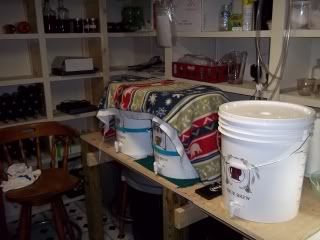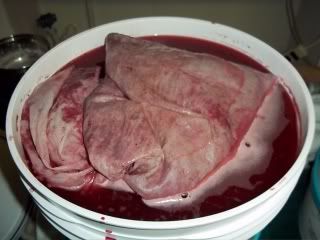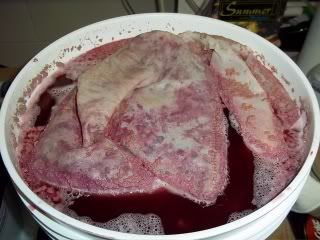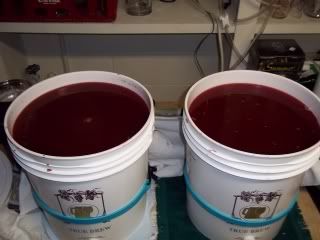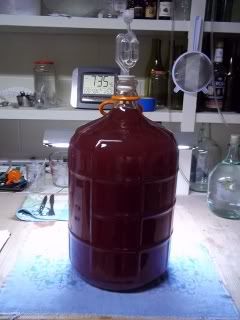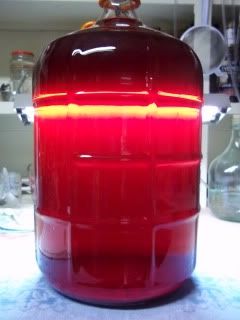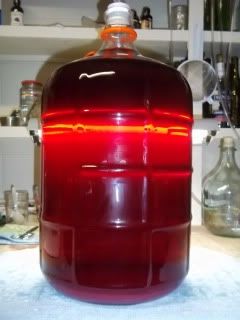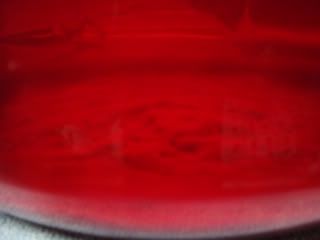dangerdave
Chief Bottlewasher
- Joined
- Jul 13, 2011
- Messages
- 2,729
- Reaction score
- 898
CLEARING THINGS UP by dangerdave
Given the depth and breadth of the winemaking industry throughout the history of mankind, I expect to view myself as a "beginner" for many years to come. We are all still learning together how best to make wine. With less than a year of experience under my belt, and no real fear of failure, I submit to you the follwing.
Here, we will do a side-by-side (by side) comparison of the use of bentonite and sparkolloid. More specifically, we will be observing the effect of bentonite on the lees and clarity of both the primary fermentation and secondary clearing of my own personal recipe for what I call Dragon Blood (some of you may know this as my Triple Berry Lemon recipe derivied from Lon's original Skeeter Pee). I am posting the recipe here, for easy reference:
_____________________________________________________
"DRAGON BLOOD"
FROM DANGERDAVE'S EASY PEESY (SKEETER PEE) RECIPE
Ingredients: For a six gallon batch:
Step 1: To a cleaned and sanitized seven gallon primary, add---in this order:
2 bottles (48 oz each) 100% Lemon Juice (ReaLemon in the green bottle): if you want to recude the acid level use one bottle.
Water to about five gallons
20 cups of white granulated sugar (looking for a SG btw 1.085-1.09): use less sugar for lower final ABV. Stir sugar until completely desolved.
1 tsp. tannin (stir)
4 tsp. yeast nutrient (stir)
2 tsp. yeast energizer (stir)
3 tsp. pectic enzyme (stir)
6 lbs. of Triple Berry Blend (raspberry/blackberry/blueberry--available in most grocery store freezer sections), frozen then thawed, in a nylon fine mesh bag (tied shut), placed in primary: Give the bag a couple of squeezes to work in pectic enzyme. May also toss fruit directly into primary, but this makes for a "messier" fermentation and subsequently will require more clearing time and racking.
Top water to six gallons
Cover primary
Place brew belt: Keep temp in 70F-80F range.
Let sit undisturbed for 12-24 hours...
Step 2: To the primary fermenter, add:
1 packet of EC-1118 Yeast (starter, per yeast directions): Sprinkle yeast into one cup of warm water (100F), let sit for 15 minutes (no longer), stir and add to primary. Other yeast strains may also work well.
Stir Primary Vigorously!
Step 3: Each day, do the following, in this order:
Check temp
Check specific gravity
Squeeze juices from fruit pack into fermenter---remove friut pack: Temporarily place in sanitized bucket.
Stir primary vigorously: To introduce oxygen into must.
Replace fruit pack
Cover primary
Step 4: When specific gravity (SG) reaches <1.000, do the following:
Squeeze juices from fruit pack into fermenter---remove friut pack: Discard fruit.
Rack to cleaned and sanitized six gallon carboy
Degas very thoroughly: I cannot emphasize this enough!
Add 1 tsp. Potassium Metabisulfite (stir)
Add 3 tsp. Potassium Sorbate (stir)
Add Sparkolloid* (or other cleaing agent): *1 tbs in one cup of water simmered for about 30 minutes. Add hot mixture to carboy.
Allow to clear undistrubed for no less than 1 week
Step 4: When wine is clear:
Carefully rack off of lees into cleaned & sanitized six gallon carboy
Add 4-5 cups of white granulated sugar (stir until sugar is completely disolved): Add more or less sugar to taste. Remember! The sugars will blend with the berry flavors over time, and the sweetness will come forward. Do not over-sweeten!
Allow wine to clear free of all sediment: This may or may not require more racking over the next few weeks.
Step 5: When wine is completely clear:
Bottle in clear bottles
Note: Never bottle cloudy wine! NEVER!
Wine is drinkable right way, but may benefit from up to a year of aging.
____________________________________________________________
We will proceed with a chronology of the events that began on the evening of June 5th, 2012. While in the Lab, I mixed up two batches of must using the above recipe.
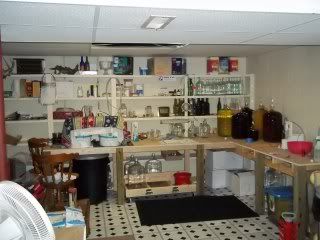
We will refer to them as batch A and batch B. The only difference between the two was the addition of bentonite to the primary fermenter of batch A. Let's see how this all turns out!
June 5th, 2012: DAY 1
Added all the necessary ingredients listed in the recipe into the two primaries. Per the bentonite package directions, I stirred 2 teaspoons into 1/2 cup of warm water, then added this mixture to the primary. I remember the first kit I ever made, almost a year ago. I was astonished to learn that the first thing I had to add to the must was mud! My lovely wife immediately pointed out that batch A looked darker. Batch A is on the left, B on the right. I covered them and let them sit quietly overnight.
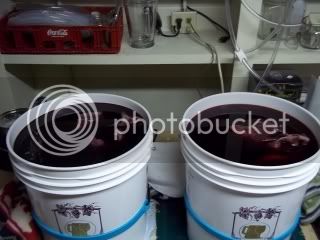
June 6th, 2012: DAY 2
The next morning at 0830, I separtely rehydrated two packets of EC-1118 yeast and added them to the primaries. Ten hours later---that evening---I checked the wines. There were "visual signs of fermentation" noted.
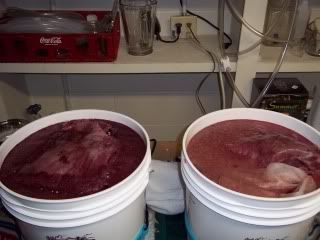
What struck me again (can you see it?) was that batch A was much darker than batch B. I carefully removed each bags of fruit, sqeezed out all the juices into the primaries, stirred each batch vigorously, and replaced the bags of fruit.
<I invite specualtion as to why the color difference between the two batches.>
June 7th, 2012: DAY 3
I squeezed and stirred each batch before I left for work at 0730. I will inspect the primaries upon my return home tomorrow.
Given the depth and breadth of the winemaking industry throughout the history of mankind, I expect to view myself as a "beginner" for many years to come. We are all still learning together how best to make wine. With less than a year of experience under my belt, and no real fear of failure, I submit to you the follwing.
Here, we will do a side-by-side (by side) comparison of the use of bentonite and sparkolloid. More specifically, we will be observing the effect of bentonite on the lees and clarity of both the primary fermentation and secondary clearing of my own personal recipe for what I call Dragon Blood (some of you may know this as my Triple Berry Lemon recipe derivied from Lon's original Skeeter Pee). I am posting the recipe here, for easy reference:
_____________________________________________________
"DRAGON BLOOD"
FROM DANGERDAVE'S EASY PEESY (SKEETER PEE) RECIPE
Ingredients: For a six gallon batch:
Step 1: To a cleaned and sanitized seven gallon primary, add---in this order:
2 bottles (48 oz each) 100% Lemon Juice (ReaLemon in the green bottle): if you want to recude the acid level use one bottle.
Water to about five gallons
20 cups of white granulated sugar (looking for a SG btw 1.085-1.09): use less sugar for lower final ABV. Stir sugar until completely desolved.
1 tsp. tannin (stir)
4 tsp. yeast nutrient (stir)
2 tsp. yeast energizer (stir)
3 tsp. pectic enzyme (stir)
6 lbs. of Triple Berry Blend (raspberry/blackberry/blueberry--available in most grocery store freezer sections), frozen then thawed, in a nylon fine mesh bag (tied shut), placed in primary: Give the bag a couple of squeezes to work in pectic enzyme. May also toss fruit directly into primary, but this makes for a "messier" fermentation and subsequently will require more clearing time and racking.
Top water to six gallons
Cover primary
Place brew belt: Keep temp in 70F-80F range.
Let sit undisturbed for 12-24 hours...
Step 2: To the primary fermenter, add:
1 packet of EC-1118 Yeast (starter, per yeast directions): Sprinkle yeast into one cup of warm water (100F), let sit for 15 minutes (no longer), stir and add to primary. Other yeast strains may also work well.
Stir Primary Vigorously!
Step 3: Each day, do the following, in this order:
Check temp
Check specific gravity
Squeeze juices from fruit pack into fermenter---remove friut pack: Temporarily place in sanitized bucket.
Stir primary vigorously: To introduce oxygen into must.
Replace fruit pack
Cover primary
Step 4: When specific gravity (SG) reaches <1.000, do the following:
Squeeze juices from fruit pack into fermenter---remove friut pack: Discard fruit.
Rack to cleaned and sanitized six gallon carboy
Degas very thoroughly: I cannot emphasize this enough!
Add 1 tsp. Potassium Metabisulfite (stir)
Add 3 tsp. Potassium Sorbate (stir)
Add Sparkolloid* (or other cleaing agent): *1 tbs in one cup of water simmered for about 30 minutes. Add hot mixture to carboy.
Allow to clear undistrubed for no less than 1 week
Step 4: When wine is clear:
Carefully rack off of lees into cleaned & sanitized six gallon carboy
Add 4-5 cups of white granulated sugar (stir until sugar is completely disolved): Add more or less sugar to taste. Remember! The sugars will blend with the berry flavors over time, and the sweetness will come forward. Do not over-sweeten!
Allow wine to clear free of all sediment: This may or may not require more racking over the next few weeks.
Step 5: When wine is completely clear:
Bottle in clear bottles
Note: Never bottle cloudy wine! NEVER!
Wine is drinkable right way, but may benefit from up to a year of aging.
____________________________________________________________
We will proceed with a chronology of the events that began on the evening of June 5th, 2012. While in the Lab, I mixed up two batches of must using the above recipe.

We will refer to them as batch A and batch B. The only difference between the two was the addition of bentonite to the primary fermenter of batch A. Let's see how this all turns out!
June 5th, 2012: DAY 1
Added all the necessary ingredients listed in the recipe into the two primaries. Per the bentonite package directions, I stirred 2 teaspoons into 1/2 cup of warm water, then added this mixture to the primary. I remember the first kit I ever made, almost a year ago. I was astonished to learn that the first thing I had to add to the must was mud! My lovely wife immediately pointed out that batch A looked darker. Batch A is on the left, B on the right. I covered them and let them sit quietly overnight.

June 6th, 2012: DAY 2
The next morning at 0830, I separtely rehydrated two packets of EC-1118 yeast and added them to the primaries. Ten hours later---that evening---I checked the wines. There were "visual signs of fermentation" noted.

What struck me again (can you see it?) was that batch A was much darker than batch B. I carefully removed each bags of fruit, sqeezed out all the juices into the primaries, stirred each batch vigorously, and replaced the bags of fruit.
<I invite specualtion as to why the color difference between the two batches.>
June 7th, 2012: DAY 3
I squeezed and stirred each batch before I left for work at 0730. I will inspect the primaries upon my return home tomorrow.
Last edited:






